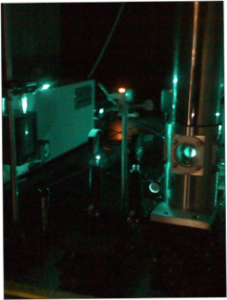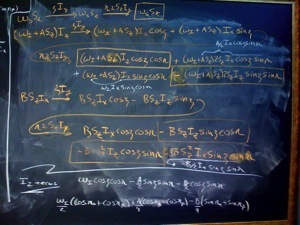
Resonance Raman Spectroscopy
This vibrational technique allows us to examine the active sites of metalloproteins. Our resonance Raman system includes three lasers, a Coherent 308 Argon-ion laser, a Coherent Krypton-ion laser, and a Coherent 599 Dye Laser for wavelength coverage from 350-800nm, and an Acton Research TriplePro triple monochromator equipped with a CCD detector. Our set up also provides a liquid helium cryostat and a liquid nitrogen finger dewars for the ability to take data from 4K to room temperature.

Electron Paramagnetic Resonance (EPR) and Electron Nuclear Double Resonance (ENDOR) Spectroscopies
EPR spectroscopy is used to detect unpaired electrons in the active sites of metalloenzymes. We use a Bruker EPR system that operates at X-band. We currently have the capabilities to go as low at 1.5K.
Stopped-Flow and Freeze Quench
Reactive intermediates can be trapped and observed spectroscopically. UV-Visible, resonance Raman, Mössbauer, EPR, and ENDOR are among many techniques that can be coupled to these rapid mixing experiments. To prepare and study reactive intermediates we use a Bio-Logic four syringe stopped-flow spectrophotometer and an Update Instruments four syringe freeze quench apparatus.

X-ray Absorption Spectroscopy (XAS)
X-ray absorption spectroscopy is an atom specific technique which utilizes synchrotron radiation to eject a core electron to give a characteristic absorption spectrum. This information can be fit to give bond distances to neighboring atoms, which is important to understanding how metalloproteins function. We utilize the SSRL (Stanford Synchrotron Radiation Laboratory) synchrotron source for these studies.
Mössbauer Spectroscopy
Gamma ray emission from a 57Co source can be used to study nuclear resonances within 57Fe substituted proteins. Since most of the interesting chemistry occurs at the Fe active sites of proteins this method of spectroscopy allows for a thorough probing of the chemical and physical environment. The elucidation of spin state, oxidation state, and number of species present within a sample are just some of the characterizations made by this method. A cryostat allows for data collection at temperatures as low as 4K.
Nuclear Resonant Vibrational Spectroscopy (NRVS) / Nuclear Resonant Inelastic X-Ray Scattering (NRIXS)
This vibrational technique is a hybrid between Mössbauer spectroscopy and resonance Raman spectroscopy, in which vibrational modes coupled to the position of the iron center can are observed after nuclear excitation of a Mössbauer-active nucleus. This new technique can provide detailed structural information while limiting the photon flux on the sample. We utilize the Advanced Photon Source (APS) at Argonne National Laboratory for these studies.
Computational and Theoretical Chemistry
Our group makes extensive use of computational techniques. Much of our research is devoted to the study of reactive protein intermediates. These systems are not amenable to crystallization. Through the careful comparison of calculated and measured observables we obtain structural and mechanistic insights.
